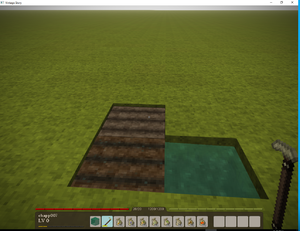Farming
Farming is a game mechanic that allows players to grow food crops for use in cooking.
Required Materials
To begin farming, a player needs good soil and seeds to plant crops. A specialized tool, the hoe is required to convert soil into farmland.
Finding Seeds
Wild crops are created during world generation and can be found all over the world in different climatic regions. Breaking these crops (left mouse button) is essential for gathering seeds to plant crops. Wild crops that are not mature do not always drop seeds when broken. Seeds can also be found in seed and farming loot vessels located in ruins.
Soil and Farmland
Naturally Generated Soil
Four types of naturally occurring soil exist in the world at different fertility rates: barren 5%, low 25%, medium 50%, and high called terra preta 80%. Soil retains its fertility levels when blocks are gathered and placed elsewhere, so a good farming strategy is to hunt soil with high nutrient levels and bring it home.
Player Created Soil
Compost is a player generated soil type with nutrient levels of 65%. This dirt is an alternative farming option if terra preta cannot be located. Each block of compost is created by sealing 64 rot in a barrel for 20 days.
Creating Farmland
Using a hoe + right mouse button on a soil block creates dry farmland. The farmland must be within 3 blocks of a water source block to convert from dry to moist farmland. The other solution to create moist farmland is daily watering using a watering can. Farmland blocks cannot be picked up and replaced once converted. Breaking farmland destroys the block.
Soil Nutrients
All soil, dirt, dry or moist farmland, has 3 nutrient levels, N, P, and K. Each crop consumes one of these nutrients. Some crops require higher values of nutrients than others, as shown in the table below. Crop growth rates also differ. Each crop has different total growth speed, which is shown by the number of growth days.
When crops advance from one growth stage to the next, they consume nutrients from the farmland on which they are planted. The required nutrient, K, P, or N, is the nutrient that will be consumed, reducing the concentration of that nutrient in the farmland. The amount of the nutrient required per growth stage is determined by dividing the Nutrient Consumption by the number of growth stages.
Nutrients in farmland slowly replenish over time and return to the maximum level per soil type. (Ex: Medium fertility will only regain nutrients to original levels). The rate of nutrient replenishment is slower with a crop, faster when empty.
Fertilizer
Fertilizer such as saltpeter, potash and bonemeal can be applied to the soil to replenish nutriments. Using a fertilizer is the only time a soil type can exceed the maximum nutrient level of the soil type.
Crops
To harvest, left click on the crop with an empty hand or harvesting tool, knife or scythe. Fully mature crops will return seeds, food, and in the case of flax, fiber. All fully mature crops have about a 5% chance to drop an extra seed when harvested. Each crop is characterized by a set of Crop Properties. Crop properties consist of the following individual properties:
- Growth Stages - The number of growth stages for a crop.
- Total Growth Days - The number of in game days it takes for a crop to be fully grown (harvestable).
- Required Nutrient - The type of nutrient (N, P, K) consumed from the farmland when a crop grows to the next stage.
- Nutrient Consumption - The total amount of the required nutrient that will be consumed over the lifetime of a crop.
- Cold/ Heat Resistant Until - Temperature range the crop can endure before it takes damage and then will yield less harvest on breaking. Generally all crops are able to keep growing only above 0°C. They might be able to endure lower temperatures without damage, but will not be able to grow under such circumstances.
Table of Available Crops
| Crop | Product | Growth Stages | Total Growth Days | Required Nutrient | Nutrient Consumption | Cold Resistant Until | Heat Resistant Until |
|---|---|---|---|---|---|---|---|
| Carrot | 7 | 4 | K | 40 | -10°C | 32°C | |
| Flax | 9 | 4.2 | K | 50 | -5°C | 40°C | |
| Onion | 7 | 3.6 | P | 35 | -1°C | 40°C | |
| Spelt | 9 | 4.4 | N | 40 | -5°C | 40°C | |
| Turnip | 5 | 3 | N | 30 | -5°C | 27°C | |
| Parsnip | 8 | 6 | P | 20 | -10°C | 32°C | |
| Rice | 10 | 4.2 | K | 50 | 8°C | 40°C | |
| Rye | 9 | 5 | N | 40 | -5°C | 40°C | |
| Soybean | 11 | 5.4 | K | 35 | -5°C | 40°C | |
| Pumpkin | 8 | 3.5 | P | 30 | -5°C | 40°C | |
| Cabbage | 12 | 6.5 | N | 40 | -5°C | 35°C |
Pumpkins are cultivated differently than all other crops. Please see the pumpkin page for detailed instructions about establishing a pumpkin patch.
Food and Cooking
See cooking for more information on player nutrition and preparing foods to eat.
Farming Video Tutorial
The video includes explanations of soil nutrients, converting soil to farmland, and crop growth rates. This video includes a view of all agricultural crops except pumpkins and does not include use of fertilizers.
| {{{title}}} | |
|---|---|
